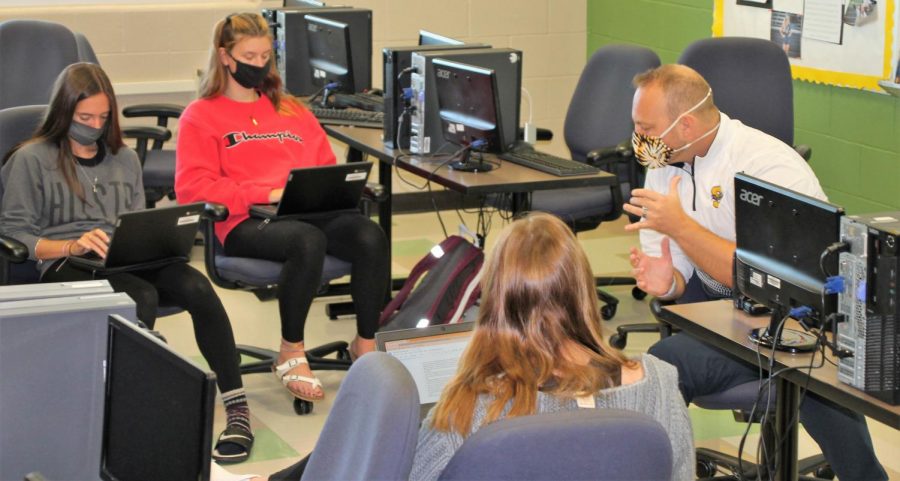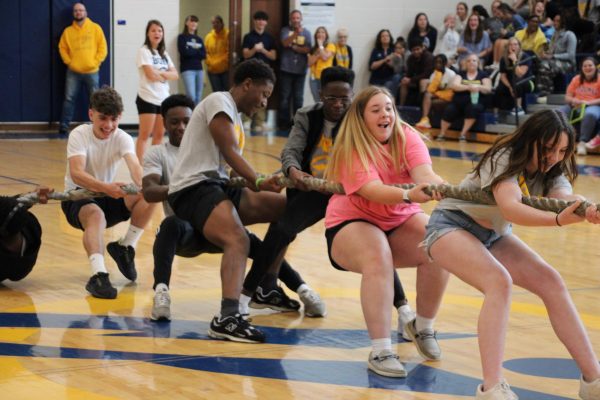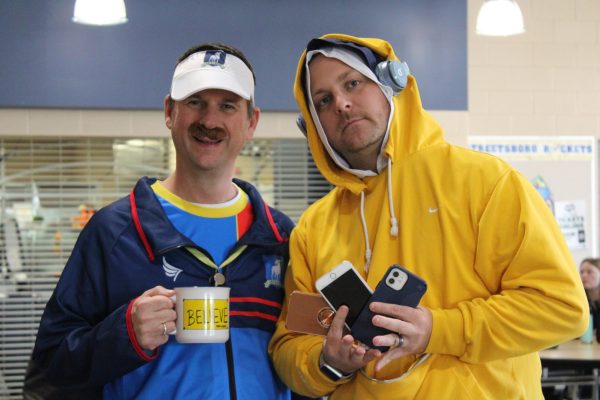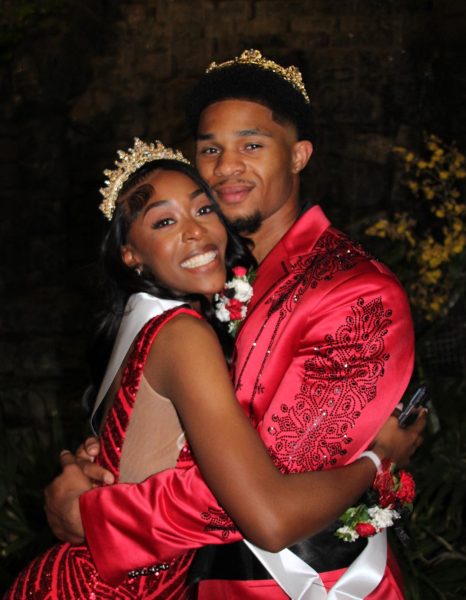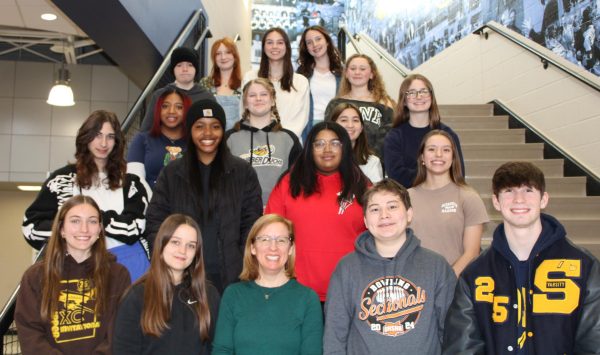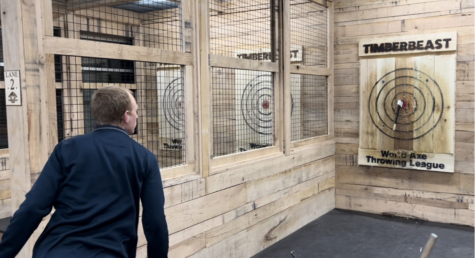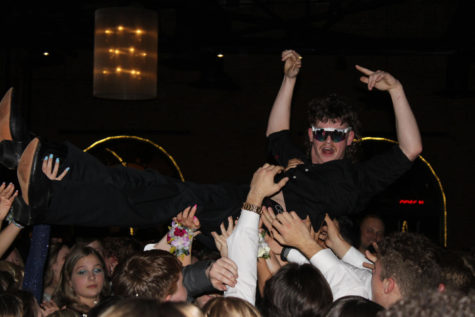Rockets masked up, but still concerned about safety, protocols
Protocols for dealing with COVID-19 here at school, have been cause for concern among the students, parents and staff.
History teacher Sherry Maruna said she was initially scared about teaching in person, but added, “I’ve actually been surprised that we are still in person, and I’m glad.”
“As long as we can do it safely, I would rather be here,” agreed history teacher Robb Kidd. “I enjoy the interaction with the students.”
Prepping for students to return to school in the fall, teachers had to make similar seating charts that “took a lot of work,” Maruna said. “Our seating charts took hours and hours.”
The idea behind the charts was to arrange students in a way that would have them sitting near the same people in as many classes as possible.
Teachers were also instructed to spray desks between each class with a product called Neutra-Stat 64. The spray is supposed to sit on surfaces for 10 minutes to work efficiently, according to www.epa.gov. The time between classes is only five minutes.
“Oops?” Maruna said.
Prior to returning to school, staff also worried about how students would handle the mask requirement.
Kidd said most students he has observed tend to wear them correctly.
When school started and it was hot in the building for a few days, Maruna said she constantly thought, “I gotta get this mask off.” But now, “I think we are just used to it,” she said.
No one is in favor of wearing masks all day.
“It’s frustrating,” said Principal Brett McCann. “No one likes wearing masks. It just is what it is…The mask is a necessity.”
As of press time, dozens of students have been sent home in waves to quarantine, but the same has not been true of the teachers.
McCann said staff has the same protocol as the students, but at one point Maruna found herself “missing about 10 kids, but I’m still here,” she said.
“Every adult has the same exact protocol as the students,” McCann explained. “If you fall within that 15 minutes, less-than-six-feet away range, you have to go.”
Parents and students have been wondering all along if and when the district will go hybrid or fully remote.
“So…I don’t have a clear answer,” McCann told reporters Nov. 19. “…Every day things are starting to change. I think there will be a point that we will go online. But I don’t think it will be as long as in the spring. I think we will go hybrid first.”
Some believe the school should go online from Thanksgiving through New Year’s Eve.
“I love that idea,” Maruna said. “It would be “unorganized and too quick” if the district were to randomly go online without being prepared, she added.
The decision to go online, hybrid, or fully in school five days a week is a difficult verdict.
“I would hate to be tasked with it,” Kidd said.
“If you look district by district, no one is doing the same thing. It’s a mess,” McCann said. “I don’t think we should go online…I don’t think anyone would say they had it better in the spring than they do now.”
Many factors impact the decisions made for the health and safety of staff and students. Everyone has differing opinions on the matter.
“Nobody’s perfect, but we are doing the best that we can,” McCann said.
Senior, Jordyn Hartley speaks on behalf of the 63% of students who voted for online school in a recent Orbiter poll. “I think virtual learning is undoubtedly hard to instruct or learn,” she said, “but at home, I’m in a calm, clean and productive environment to get my schooling done.”
Junior Anthony Byers agreed that school should move online because it is “the most practical way of slowing the spread of COVID.”
Byers said that regardless of the COVID cases Streetsboro already has, the district should move forward and protect the students’ future.
Junior Jada Paul said, “I would like to go online but I wouldn’t be against the idea of hybrid.”
Paul said she almost feels like Streetsboro is past the option of hybrid. “I think that we just shouldn’t come back after Thanksgiving break or even the holidays, because you don’t know who people are going to be around.”
Hartley said Streetsboro COVID protocols are not enough at this point. “Classes are still crammed to capacity, halls are filled shoulder to shoulder, while staff are still walking the wrong way. Masks are mandatory but, are they really?”
She added, “I have seen numerous student to staff, student to student and staff to staff interactions without proper mask protocols being followed.” Byers noted, “The stairwells at our school are jammed with students at the end of every class period, and many of the students are in very close contact with each other and touching railings.”
Students in such close proximity is contradicting one of the main protocols of the school: social distancing.
When there is a new case in the district, Hartley feels as though students, staff and families are not being informed honestly or in a proactive manner.
“It’s a guessing game who will have it next or when someone will go back home for another 14-day quarantine,” she said.
Hartley and others said they wish they would be better informed when the school hasa new positive COVID case. They would like to know more about when this student was in school, what classes the person takes, where the student sits and who they see outside of school.
HIPPA privacy laws prohibit administrators from releasing too many details about each positive case.
“But contact tracing would be no issue if school was virtual,” Hartley added.
Schools such as Hudson, Twinsburg and Aurora keep the history of the COVID positives on the dashboards. Viewers are able to see the date of positive cases.
Not only would students like to see the announcement protocols changed, but also the cleaning protocols supposed to keep the students and staff safe.
“I’ve seen many things go against COVID protocols,” Hartley said, “such as the ‘one way’ hallways that staff and students still ignore, passing out paper assignments that have to be given back and forth between your teacher and you, no sanitation on desks, large gatherings with mask down and an overflow of students in classes.” Students want the school board to do what is best to keep everyone healthy. “Being in school is absolutely not safe, whether it be for students or not,” Harley continued. “Not all, but most of our teachers and staff, are in the age group where this could be detrimental to their health and family’s health, as well as students’.”
Byers said, “I think our school board should be making informed decisions based on what students feel safest, because we — along with staff — are in this high risk zone for seven hours a day, five days a week.”
“If I was on the board school, I would have never started as a normal year in the first place,” Hartley said. “Case numbers go up daily and they are still going.”
According to WLWT5, h there were 318,828 COVID cases in Ohio alone as of Nov. 18.
Some in Streetsboro feel as though the board is waiting for “a hospital visit” or something bad to happen, rather than to be proactive about protecting students before these things happen.
Hartley, Byers and Paul posed these questions for the Board of Education: Streetsboro board anything they would ask,
“Do we need to see a student or faculty member be admitted to the hospital and be put on a ventilator, or even die, before you can realize that you are costing lives every day by keeping our schools open?” — ?
“How many parents, guardians and family members do you think are contracting COVID-19 every day because of students coming to and from this COVID infested building day in and day out?” — ?
“Can you listen to the students and staff and take our ideas into consideration?”
“What are you doing, and why are we avoiding the hard-to-ask questions that are necessary to protect the health of so many people?”
Your donation will support the student journalists of Streetsboro High School. Your contribution will allow us to purchase equipment and cover our annual website hosting costs.


